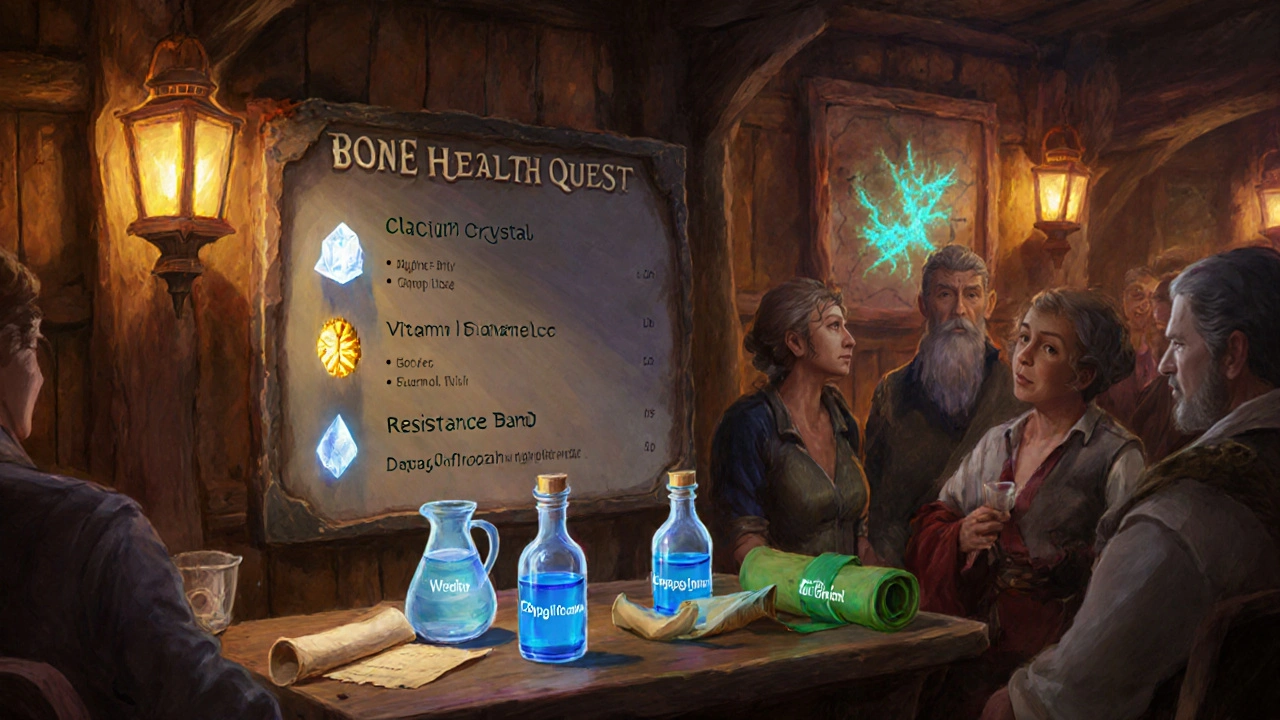Bone Health Risk Calculator
Your Bone Health Risk Assessment
Quick Takeaways
- Canagliflozin may slightly raise fracture risk, especially in older women with low bone density.
- Type2 diabetes itself weakens bone quality, so any added drug effect matters.
- Regular monitoring of calcium, vitaminD, and bone‑mineral‑density (BMD) can catch problems early.
- If you have a history of fractures, discuss alternative SGLT2 inhibitors or dose adjustments with your doctor.
- Staying active, eating enough protein, and limiting alcohol support bone health while on diabetes medication.
What is Canagliflozin?
When you hear Canagliflozin is a SGLT2 inhibitor used to lower blood sugar in adults with type2 diabetes, you probably focus on glucose control. The drug blocks the sodium‑glucose co‑transporter‑2 in the kidneys, causing excess glucose to leave the body in urine. By doing so, it reduces HbA1c by about 0.5‑1.0% and can aid weight loss. Approved by the FDA in 2013, it has become a staple in many treatment plans.
While its primary goal is glycemic management, the kidney‑centric mechanism also influences fluid balance, electrolytes, and-interestingly-bone metabolism.
Diabetes and Bone Health: A Two‑Way Street
Type 2 diabetes is a chronic condition characterized by insulin resistance and high blood sugar. Beyond heart disease and kidney damage, diabetes affects bone in three main ways:
- Advanced glycation end‑products (AGEs) accumulate in collagen, making bone less flexible.
- Insulin deficiency reduces the anabolic signal that helps build bone.
- Microvascular disease impairs blood flow to bone tissue, slowing repair.
Studies show that people with type2 diabetes have up to a 30% higher fracture risk compared with non‑diabetic peers, even when bone mineral density appears normal. For this reason, any medication that touches calcium or phosphate handling deserves close scrutiny.

Evidence Linking Canagliflozin to Fracture Risk
When the CANVAS trial was published in 2017, researchers reported a modest increase in lower‑extremity fractures among participants on canagliflozin versus placebo (1.5% vs 1.2% over three years). The signal was most evident in women over 65 with baseline osteoporosis.
Subsequent meta‑analyses (2021, 2023) pooled data from more than 10,000 patients. Two key findings emerged:
- The relative risk of any fracture rose by roughly 12% for canagliflozin users.
- Hip and vertebral fractures showed the strongest association, while wrist fractures were unchanged.
Why might this happen? Canagliflozin modestly raises urinary calcium excretion, which can lower serum calcium if intake is insufficient. The drug also leads to mild volume depletion, potentially triggering secondary hyperparathyroidism-a state that encourages bone resorption.
Other SGLT2 inhibitors, such as empagliflozin and dapagliflozin, have not shown a clear fracture signal in large trials, suggesting the risk may be drug‑specific rather than class‑wide.
Practical Tips for Patients on Canagliflozin
If you’re already taking canagliflozin, consider these easy steps to protect your skeleton:
- Schedule a baseline bone mineral density (BMD) test with a DXA scan to assess your current bone health. Repeat every 2-3 years if you have risk factors.
- Make sure you get at least 1,200mg of calcium and 800-1,000IU of vitaminD daily, unless your physician advises otherwise.
- Stay hydrated. Adequate fluid intake reduces the chance of excessive urinary calcium loss.
- Include weight‑bearing exercise (e.g., brisk walking, resistance bands) at least three times a week.
- Limit caffeine and alcohol, both of which can accelerate calcium loss.
Discuss any history of fractures, osteoporosis, or kidney disease with your prescriber. In some cases, doctors may switch to an SGLT2 inhibitor with a cleaner bone profile or lower the canagliflozin dose.
Monitoring and Alternatives
Regular lab work can catch early signs of bone strain:
| Test | Frequency | What to Watch For |
|---|---|---|
| Serum calcium & phosphate | Every 6 months | Drop below 2.2mmol/L |
| Parathyroid hormone (PTH) | Annually | Elevated levels indicating secondary hyperparathyroidism |
| VitaminD | Annually | 25‑OH‑vitaminD < 30ng/mL |
| DXA scan (BMD) | Every 2-3 years | T‑score ≤‑2.5 suggests osteoporosis |
If labs show trouble, your doctor might add a bisphosphonate, switch to a different SGLT2 inhibitor, or combine canagliflozin with a GLP‑1 receptor agonist that carries no bone risk.

Comparison of Bone Safety Among SGLT2 Inhibitors
| Drug | Fracture Risk↑ (Relative) | Urinary Calcium ↑? | FDA Warning |
|---|---|---|---|
| Canagliflozin | 1.12 | Yes (modest) | Label mentions possible bone loss |
| Empagliflozin | 0.99 | No significant change | None |
| Dapagliflozin | 1.01 | No significant change | None |
The table shows that canagliflozin is the only SGLT2 inhibitor with a consistent, albeit small, increase in fracture risk. For patients with fragile bones, picking an alternative may be a safer route.
Key Takeaways for Everyday Life
Putting the pieces together, the connection between canagliflozin, diabetes, and osteoporosis looks like this:
- Diabetes already weakens bone quality.
- Canagliflozin can raise urinary calcium loss and trigger mild secondary hyperparathyroidism.
- Clinical data point to a roughly 10‑15% higher fracture risk, mostly in older women.
- Simple actions-adequate calcium/vitaminD, regular BMD checks, staying active-can offset much of the added risk.
Talk to your healthcare team if any of these points raise concern. Tailoring therapy to your bone profile is a smart move, especially as you age.
Frequently Asked Questions
Does canagliflozin cause osteoporosis?
It does not directly cause osteoporosis, but studies suggest it can increase fracture risk slightly, especially in people who already have low bone density.
Should I stop taking canagliflozin if I have a history of fractures?
Not automatically. Discuss alternatives with your doctor, who may switch you to another SGLT2 inhibitor or adjust the dose while monitoring bone health closely.
How often should I get a bone‑density scan while on canagliflozin?
A baseline DXA scan is recommended, followed by repeats every 2-3years if you have risk factors such as age >65, female sex, or low calcium intake.
Can supplements counteract the bone effects of canagliflozin?
Adequate calcium (1,200mg) and vitaminD (800‑1,000IU) are helpful. They won’t erase the drug’s effect completely, but they can keep serum levels in the normal range.
Are other SGLT2 inhibitors safer for my bones?
Current evidence shows empagliflozin and dapagliflozin have no clear signal for increased fractures, making them alternatives for patients concerned about bone health.

ruth purizaca
July 31, 2025 AT 12:58The interplay between SGLT2 inhibition and calcium homeostasis presents a fascinating biochemical curiosity. While the CANVAS trial hinted at a modest fracture signal, the underlying mechanisms remain a topic of scholarly debate. Increased urinary calcium excretion coupled with mild volume depletion may stimulate secondary hyperparathyroidism, subtly shifting the remodeling balance. Moreover, the differential effect observed among canagliflozin versus its class counterparts suggests a molecule‑specific nuance. In any case, clinicians should remain vigilant when prescribing to osteopenic patients.
Shelley Beneteau
August 7, 2025 AT 03:58Building on that, it's worth noting that the AGE‑mediated collagen cross‑linking in diabetic bone impairs micro‑damage repair independently of SGLT2 activity. Consequently, any additional calcium loss could tip the scales toward fragility. Recent longitudinal cohorts have stratified risk by baseline BMD, showing a sharper fracture incline in women over 65 who started canagliflozin. This aligns with the hypothesis that drug‑induced calcium flux compounds pre‑existing diabetic bone deficits. Practically, incorporating periodic serum PTH checks could offer an early warning system.
Sonya Postnikova
August 13, 2025 AT 18:58Great points, everyone! 😊 Staying on top of calcium and vitamin D intake is a simple yet powerful strategy, and a regular DXA scan can keep you ahead of any sneaky bone loss. Keep those weight‑bearing workouts coming, and don't forget to hydrate – the kidneys will thank you. If you ever feel unsure, a quick chat with your endocrinologist can clear up the best supplement regimen. You've got this!
Anna Zawierucha
August 20, 2025 AT 09:58Oh wow, another drug that “maybe” nudges your bones a bit – because we all love a good plot twist with our glucose control. It's like buying a fancy sports car that secretly leaks oil; you enjoy the speed until the mechanic shows up with a bill. If canagliflozin were a movie, it'd be the sequel nobody asked for, starring “Minor Fracture Risk” as the surprise villain. Anyway, copy that warning label and keep an eye on your calcium.
Mary Akerstrom
August 27, 2025 AT 00:58just a heads up if you’re on canagliflozin make sure you get enough calcium and vitamin d it’s easy to forget and the drug can make you lose a bit more calcium in urine staying active helps keep your bones strong also keep an eye on your doctor for regular bone checks
Delilah Allen
September 2, 2025 AT 15:58Listen, the notion that a modest 12% increase in fracture risk can be brushed aside is intellectually lazy!; the very foundation of osteopathic health is being undermined by a pharmaceutical that tosses calcium into the urine like confetti!; we must demand rigorous longitudinal data, not just “some trials” that conveniently highlight benefits while downplaying skeletal sabotage!; consider the ethical ramifications of prescribing a drug that could erode the very scaffolding of our patients!
Nancy Lee Bush
September 9, 2025 AT 06:58Wow, the data really does paint a nuanced picture, doesn’t it?; especially when you factor in age, sex, and baseline BMD; the risk isn’t uniform, it’s stratified, and that’s crucial 😮; so, a personalized monitoring plan-serum calcium, PTH, vitamin D levels-becomes not just advisable but essential; keep the conversation going with your healthcare team! 😊
Dan Worona
September 15, 2025 AT 21:58What they don’t tell you in the press releases is that the pharma giants have a vested interest in downplaying any bone‑related side effects of canagliflozin. The “minor fracture risk” narrative is part of a larger agenda to keep patients glued to their glucose‑lowering drugs while the real agenda is profit, not health. Keep your eyes peeled for hidden clauses in the prescribing information, and demand independent studies.
Chuck Bradshaw
September 22, 2025 AT 12:58As anyone familiar with the pharmacodynamics of SGLT2 inhibitors will tell you, the modest increase in urinary calcium is a predictable consequence of altered renal handling of electrolytes. The meta‑analyses you cited corroborate this mechanistic pathway, and the lack of a similar signal with empagliflozin underscores the molecule‑specific effect. Therefore, clinicians should tailor therapy based on individual bone health profiles.
Howard Mcintosh
September 29, 2025 AT 03:58Yo folks, if you’re on canagliflozin don’t forget to load up on calcium-like 1200mg a day-and snag that vitamin D. Stay hydrated, hit the gym with some weight‑lifting, and keep those bone scans on the calendar. It’s simple, it works, and you’ll stay strong while the meds do their thing!
Jeremy Laporte
October 5, 2025 AT 18:58Exactly, man! I’d add that swapping to empagliflozin if you’ve got bone concerns is a smart move, and setting a reminder for your DXA every couple of years keeps everything on track.
Glenn Gould
October 12, 2025 AT 09:58Hey team, keep that calcium intake high and squeeze in some squats-your bones will thank ya! Don’t let the med’s side‑effects hold ya back.
Julien Martin
October 19, 2025 AT 00:58The pharmacokinetic profile of canagliflozin reveals a renal clearance pathway that intersects with calcium homeostasis via the proximal tubule Na⁺/Ca²⁺ exchanger. Consequently, the drug’s osmotic diuresis potentiates calciuric loss, necessitating a compensatory upregulation of parathyroid hormone synthesis to maintain serum calcium equilibrium. From a clinical standpoint, integrating serial biomarkers-serum calcium, phosphate, and intact PTH-into the therapeutic monitoring algorithm can mitigate the incremental fracture risk observed in longitudinal cohort analyses.
Lolita Rosa
October 25, 2025 AT 15:58Ugh, can you believe we’re expected to trust a medication that might subtly erode our bones while promising lower HbA1c? It feels like being handed a glittering promise that’s actually just a sugar‑coated trap. The whole “minor risk” disclaimer reads like a whisper in a hurricane.
Matthew Platts
November 1, 2025 AT 05:58Honestly, I just stick to my routine-calcium, vitamin D, and a quick walk. If the doc thinks canagliflozin is fine, I’m good.
Kasey Mynatt
November 7, 2025 AT 20:58Hey, I get the concern-you don't have to accept any risk without a plan. Setting up a baseline DXA, ensuring you hit that 1,200 mg calcium goal, and keeping a vitamin D supplement on hand can make the difference between peace of mind and worry.
Edwin Pennock
November 14, 2025 AT 11:58While the prevailing narrative emphasizes a modest uptick in fracture incidence among canagliflozin users, the statistical significance of that increase is marginal at best. First, the confidence intervals in several meta‑analyses cross unity, suggesting that the observed effect could be due to random variation. Second, many of the cited trials were not powered specifically to detect skeletal outcomes, rendering the fracture data under‑powered. Third, the patient populations in those studies often had concurrent osteoporosis therapies, which confound attribution of fractures to the SGLT2 inhibitor itself. Fourth, the biochemical mechanism-enhanced calciuria-is transient and typically compensated by homeostatic regulatory loops. Fifth, clinicians routinely prescribe calcium and vitamin D supplements alongside canagliflozin, neutralizing any potential loss. Sixth, real‑world evidence from large insurance databases shows no appreciable rise in hospitalization for fractures after adjusting for age and comorbidities. Seventh, the alternative SGLT2 inhibitors have not been subjected to the same level of scrutiny, yet they are assumed safer without comparable data. Eighth, focusing on a single drug distracts from the broader issue that type 2 diabetes itself predisposes patients to bone fragility irrespective of glucose‑lowering agents. Ninth, lifestyle interventions-exercise, smoking cessation, and dietary optimization-remain the most effective strategies for bone preservation, far outweighing pharmacologic nuances. Tenth, the FDA’s warning label for canagliflozin acknowledges a potential risk but also notes that the absolute risk increase is small. Eleventh, patient education about proper hydration and supplementation can further mitigate any theoretical risk. Twelfth, the cost‑benefit analysis still heavily favors canagliflozin for many patients due to its cardiovascular and renal benefits. Thirteenth, emerging data on the combination of SGLT2 inhibitors with GLP‑1 receptor agonists suggest synergistic effects without additional bone harm. Fourteenth, the medical community should prioritize individualized risk assessment over blanket avoidance. Fifteenth, ongoing longitudinal studies will clarify the true magnitude of any skeletal impact. Ultimately, sweeping conclusions about canagliflozin’s danger to bone health are premature and may unnecessarily limit access to an otherwise beneficial therapy.